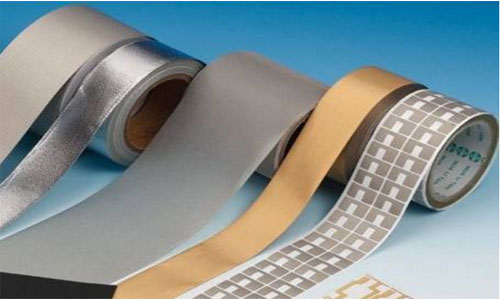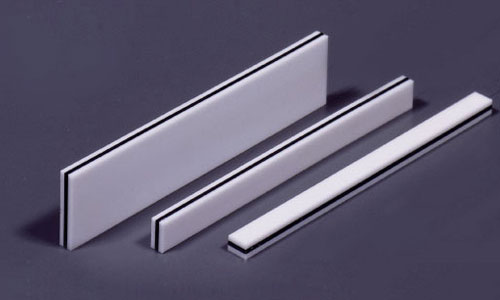Die-cutting materials | Characteristics of conductive adhesives
What is conductive adhesive:
Conductive adhesive is an adhesive that exhibits certain conductivity after curing or drying. It is typically composed of a base resin and conductive fillers (i.e. conductive particles as the main component). The conductive particles are bound together by the base resin to form a conductive path, achieving the conductive connection of adhesive materials.

Composition of conductive adhesive:
The particle size and shape of conductive fillers directly affect the conductive performance of the adhesive. The conductive effect of large particle size fillers is better than that of small particle size fillers, but it also reduces the bonding strength. The electrical conductivity and bonding strength of amorphous fillers are superior to spherical fillers. However, anisotropic conductive adhesives consist of spherical fillers with narrow particle size distribution. Using fillers of different particle sizes and shapes can achieve better electrical conductivity and bonding strength.
Conductive fillers are generally classified into three categories: carbon, metal, and metal oxides. Carbon-based materials such as carbon black exhibit good conductivity but pose processing challenges; graphite is not easily broken and dispersed, and its conductivity varies greatly depending on the origin. Metal oxides typically exhibit poor conductivity.

Conductive adhesive classification:
1. According to the matrix, it can be divided into thermoplastic conductive adhesive and thermosetting conductive adhesive.
The molecular chains of the base resin of thermoplastic conductive adhesives are very long and almost unbranched. When cured at high temperatures, it exhibits good flowability and can be reused. The base material of thermosetting conductive adhesives is initially monomers or prepolymers. During the curing process, a polymerization reaction occurs, and polymer chains connect to form a cross-linked three-dimensional network structure, which is not easily flowable at high temperatures.
Secondly, it is divided into intrinsic conductive adhesive and composite conductive adhesive according to the conductive mechanism.
Intrinsic conductive adhesives refer to conjugated polymers with conductive functionality in their molecular structure. Such materials have high resistivity, poor conductive stability and repeatability, and high cost, therefore they are rarely studied.
Composite conductive adhesive refers to the addition of conductive fillers to an organic polymer matrix, giving it conductivity similar to metal.
2. According to the conduction direction, it is divided into two types: isotropic conductive adhesives (ICAs) and anisotropic conductive adhesives (ACAs):
(1) Isotropic conductive adhesives have the same electrical conductivity in all directions;
(2) Anisotropic conductive adhesives are insulated in the XY direction and conductive in the Z direction. By selecting fillers of different shapes and amounts, they can be made into isotropic or anisotropic conductive adhesives.
(3) According to different curing systems, conductive adhesives can be classified into room temperature curing conductive adhesives, medium temperature curing conductive adhesives, high temperature curing conductive adhesives, and UV curing conductive adhesives.

The time required for room temperature curing is too long, usually taking several hours to several days, and the volume resistivity is prone to change when stored at room temperature, therefore it is rarely used in industry.
Medium temperature curing conductive adhesives have excellent mechanical properties, and the curing temperature is generally below 150°C, which can better match the operating temperature and thermal resistance of electronic components, so it is currently widely used in conductive adhesives.
High temperature curing conductive adhesives oxidize metal particles easily after high temperature curing, and the curing time must be short when using conductive adhesives, so the amount used is also small.
UV curing conductive adhesives mainly rely on UV to induce the curing reaction of the resin matrix. It cures faster and the resin matrix can be preserved for a longer time under light-shielding conditions. This is a new type of curing method.
(4) Conductive adhesives classified by conductive particles include gold conductive adhesive, silver conductive adhesive, copper conductive adhesive, carbon conductive adhesive, carbon nanotube conductive adhesive, etc.
(5) That's all for today's introduction to conductive adhesives. Do you have a clearer understanding of the classification criteria for conductive adhesives? Conductive adhesives, as one of the die-cutting materials, have a complex manufacturing process, and only a high-quality die-cutting machine can control the process well. The Fumart Rotary Die Cutting Machine, which has been deeply engaged in the die-cutting industry for many years, is your best choice.
Contact: Pamela
Phone: +86 189 6365 3253
E-mail: info@industryprocess.com
Whatsapp:+86 189 6365 3253
Add: Yajing Industrial Park, No. 59 Shuangjing Street, Weiting Town, Suzhou Industrial Park
We chat
